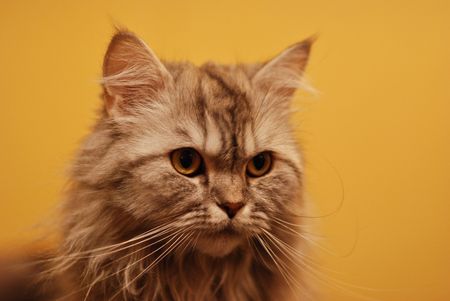Understanding Ideal Cat Weight
What Is a Healthy Weight for Cats?
If you’ve ever wondered if your cat is too fluffy or actually overweight, you’re not alone. Cats come in all shapes and sizes, but there are some basic guidelines that can help you understand what a healthy weight looks like. Most adult domestic cats weigh between 8 to 10 pounds, but this can vary depending on the breed, age, and body frame.
Average Healthy Weight Ranges for Common Cat Breeds
| Breed | Healthy Weight Range (lbs) |
|---|---|
| Domestic Shorthair | 8-10 |
| Siamese | 6-10 |
| Maine Coon | 10-18 |
| Persian | 7-12 |
| Bengal | 8-15 |
What Is Body Condition Scoring?
The number on the scale isn’t everything. Vets use something called Body Condition Scoring (BCS) to assess your cat’s overall shape and health. BCS is usually measured on a scale from 1 to 9, where 1 means severely underweight, 5 is ideal, and 9 is severely obese. It’s more about how your cat looks and feels than just their weight.
How to Check Your Cat’s Body Condition at Home:
- Ribs: You should be able to feel (but not see) your cat’s ribs easily with gentle pressure.
- Waist: When looking from above, your cat should have a visible waist behind the ribs.
- Belly: From the side, there should be a slight tummy tuck—not a big round belly hanging down.
Chubby vs. Overweight: What’s the Difference?
A little extra fluff is adorable, but being overweight puts cats at risk for diabetes, arthritis, and other health problems. A “chubby” cat might have a bit of softness but still shows signs of an hourglass shape and moves around easily. An overweight cat will have a rounder shape with little or no waistline, difficulty grooming themselves, or less willingness to jump and play.
Feeding Habits and Nutrition
Smart Feeding Guidelines
Helping your cat keep a healthy weight starts with smart feeding habits. Cats thrive on routine, so feed them at the same times every day. Avoid free-feeding (leaving food out all day) as it can lead to overeating. Instead, use set meal times and measure portions carefully. If your schedule is busy, consider an automatic feeder to help keep meals consistent.
How to Read Pet Food Labels
Understanding pet food labels is key to making the right choices for your cat. Look for high-quality protein as the first ingredient, and avoid foods with excessive fillers like corn or by-products. Pay attention to calories per serving and serving size recommendations. The following table breaks down what to look for on a typical cat food label:
| Label Section | What to Look For |
|---|---|
| Main Ingredients | Named protein (chicken, salmon, turkey), not generic meat or by-product |
| Calorie Content | Calories per cup or can; helps you determine portion size |
| Nutritional Adequacy | “Complete and balanced” for your cats life stage (kitten, adult, senior) |
| Avoid List | Artificial flavors, colors, preservatives; excess fillers like corn or soy |
Appropriate Treat Routines
Treats are a fun way to bond with your cat, but they can add up quickly in calories. Treats should make up no more than 10% of your cat’s daily calorie intake. Choose healthy treats—like freeze-dried meat—or try offering a small piece of cooked chicken or fish. Remember to subtract treat calories from your cats total daily allowance.
Quick Treat Tips:
- Use treats for training or enrichment—not just because they’re cute!
- Avoid high-calorie commercial treats with lots of additives.
- If your cat loves treats, break them into smaller pieces to stretch them further.
The Role of Portion Control in Weight Management
Portion control is one of the most effective ways to prevent weight gain in cats. Always measure your cat’s food using a standard measuring cup or kitchen scale. Don’t rely on “eyeballing” servings—cat food is calorie-dense and even small overages add up over time. Your vet can help you calculate the ideal daily calorie goal for your individual cat based on age, activity level, and body condition.

3. The Importance of Daily Activity
Keeping your cat active is just as important as managing their diet when it comes to a healthy weight. Unlike outdoor cats, most indoor cats don’t have the chance to chase birds or climb trees. That’s why it’s up to you to make playtime a regular part of their daily routine. Not only does daily activity help your cat burn calories, but it also keeps them mentally stimulated and happy.
Fun and Easy Ways to Encourage Play
Cats love variety, so switch up their toys and activities to keep things interesting. Here are some simple ideas:
- Interactive toys: Try laser pointers, feather wands, or battery-operated mice that move on their own.
- DIY games: Crumple paper balls, use empty boxes, or set up tunnels with paper bags for hide-and-seek fun.
- Cat trees and shelves: Give your cat vertical space for climbing and jumping.
- Treat puzzles: Hide dry food in puzzle feeders to combine mental and physical exercise.
Sample Weekly Activity Schedule for Indoor Cats
| Day | Activity Suggestion | Estimated Playtime |
|---|---|---|
| Monday | Feather wand chase | 15 minutes |
| Tuesday | Treat puzzle feeder | 10 minutes |
| Wednesday | Laser pointer session | 15 minutes |
| Thursday | Hide-and-seek with boxes | 10 minutes |
| Friday | Interactive mouse toy | 15 minutes |
| Saturday | Tower climbing & jumping practice | 10 minutes |
| Sunday | Cuddle & gentle wrestling with soft toy | 10 minutes |
Create Healthy Habits Naturally at Home
The key is consistency. Make playtime a part of your everyday routine—before breakfast or after dinner works great for most families. You can even get creative by hiding small treats around the house to encourage your cat to explore and stay active. With a little planning and some fun activities, you’ll help your cat maintain a healthy weight while strengthening your bond together.
4. Monitoring Progress at Home
Tips for Regular Weight Checks
Keeping tabs on your cat’s weight at home is a smart move, and it doesn’t have to be complicated. Aim to weigh your cat every two to four weeks. Consistency matters more than frequency, so pick a day that works for you and stick with it. Early morning, before breakfast, is best—just like we do for ourselves.
How to Weigh Your Cat at Home
You don’t need fancy equipment—a regular digital bathroom scale will do the trick. Here’s a simple way:
- Step on the scale yourself and note your weight.
- Pick up your cat and step on the scale again (if they’ll let you!).
- Subtract your weight from the combined total. That’s your cat’s weight.
Sample Weight Tracking Table
| Date | Your Weight (lbs) | With Cat (lbs) | Cats Weight (lbs) | Notes |
|---|---|---|---|---|
| June 1 | 150 | 161.5 | 11.5 | Mildly squirmy, try treats next time |
| June 15 | 150 | 161.0 | 11.0 | Smoother process! |
Tracking Your Cat’s Body Changes
Besides numbers, pay attention to how your cat looks and feels. Run your hands along their ribs—can you feel them without pressing hard? Is there a visible waist when viewed from above? These are signs of a healthy body condition. If you notice changes in muscle tone or if your cat seems to be getting rounder or thinner, jot it down in your notes.
Cues to Watch For:
- Easier rib check: Good sign!
- No waistline: Time to review food portions or activity.
- Saggy belly fat (“belly flap”): Common in some cats but monitor if it grows.
- Lack of muscle over spine or hips: May need more protein or vet advice.
Using Household Tools for Stress-Free Weigh-Ins
If your cat gets nervous on the scale, try placing a familiar towel or favorite blanket on it first. You can also use treats as rewards after each weigh-in session. Some pet parents even use baby scales for smaller cats—they’re accurate and have a cozy surface.
Remember, these home checks are about progress, not perfection. Small changes over time make a big difference in keeping your feline friend healthy and happy!
5. When to Seek Professional Help
If you’ve been working hard to help your cat maintain a healthy weight but aren’t seeing the results you hoped for, it may be time to get your veterinarian involved. Sometimes, weight issues in cats go beyond what you can fix at home with diet and exercise alone. Here’s how to recognize when it’s time to seek professional help—and what you can expect from a veterinary weight management plan.
Recognizing the Signs Your Cat Needs Veterinary Input
Cats are masters at hiding health problems, so it’s important to watch closely for signs that their weight might be more than just a simple overfeeding issue. Some signals that your cat needs veterinary support include:
| Sign | What It Might Mean |
|---|---|
| Sudden or unexplained weight gain or loss | Possible underlying medical condition (like diabetes or thyroid disease) |
| Lack of energy or unusual tiredness | Obesity-related fatigue or illness |
| Difficulty breathing or moving around | Obesity impacting joint and respiratory health |
| No change in weight despite diet changes | Metabolic issues or incorrect calorie calculations |
| Excessive hunger, begging, or food-seeking behavior | Imbalanced nutrition or possible hormonal disorders |
What to Expect from a Veterinary Weight Management Plan
Your vet will take a holistic approach to your cat’s health and may run tests to rule out any medical conditions affecting their weight. Here’s what a typical vet-guided plan might include:
Initial Assessment
- A physical exam and discussion about your cat’s eating habits, activity level, and environment.
- Lab work (bloodwork and possibly urine tests) to check for illnesses like diabetes, hyperthyroidism, or kidney disease.
- A body condition score (BCS) evaluation to measure how much excess fat your cat is carrying.
Customized Weight Loss Plan
- Your vet may recommend a prescription diet designed for safe weight loss.
- You’ll get advice on proper portion control based on your cat’s ideal weight—not current weight.
- An activity plan tailored to your cat’s age and mobility.
- Regular follow-ups to monitor progress, adjust the plan if needed, and ensure your cat is losing weight at a safe rate (usually 1-2% of body weight per week).
Support and Guidance
- Your vet will provide tips for managing begging behavior, finding low-calorie treats, and keeping your cat engaged and active at home.
- You’ll have access to resources for ongoing support—think handouts, phone check-ins, or even telemedicine visits if needed.
The Bottom Line: Don’t Hesitate to Ask for Help!
If you’re worried about your cat’s weight or overall health, reaching out to your veterinarian is always the right move. With expert guidance, you can make sure your furry friend gets back on track safely and stays happy and healthy for years to come.
6. Lifestyle Tweaks for Long-Term Success
Helping your cat maintain a healthy weight isn’t just about portion control or picking the right food—it’s about creating an environment and daily habits that set your furry friend up for success. Here’s how you can make simple, practical changes at home and in your routines to support your cat’s health journey over the long run.
Upgrade Your Cat’s Environment
Cats thrive when their environment encourages activity and curiosity. Small adjustments around your house can make a big difference in keeping your cat active and engaged.
| Home Adjustment | How It Helps |
|---|---|
| Cat Trees & Shelves | Encourage climbing and jumping to burn more calories. |
| Window Perches | Offer mental stimulation by letting your cat watch birds and outdoor action. |
| Interactive Toys | Keep your cat moving with chase, pounce, and hunt games. |
| Food Puzzle Feeders | Make mealtime active instead of passive, slowing eating and upping movement. |
Make Activity Part of Every Day
A sedentary lifestyle is one of the biggest contributors to feline weight gain. Incorporate regular play sessions into your routine—just 10-15 minutes twice a day can work wonders. Wand toys, laser pointers, or even tossing a crumpled paper ball can get your cat moving. If you have a busy schedule, set reminders on your phone so playtime doesn’t get lost in the shuffle.
Daily Routine Tips
- Schedule Play Sessions: Morning and evening are usually when cats are most active.
- Switch Up Toys: Rotating toys keeps things interesting and prevents boredom.
- Include the Family: Get everyone involved in playtime for extra bonding and fun.
- Monitor Weight Weekly: Use a pet scale or weigh yourself holding your cat (then subtract your weight).
Treats: Out of Sight, Out of Mind
If treats are always within reach, it’s easy to overdo it. Store treats in a cabinet or high shelf so they aren’t tempting for you—or for curious paws. When you do give treats, count them as part of your cat’s daily calorie intake.
Treat Alternatives Table
| If Your Cat Loves… | Try This Instead |
|---|---|
| Dried Fish Snacks | A few kibbles from their daily food allowance |
| Creamy Treats | A lick of tuna water (in moderation) |
| Bread or Cheese Bits | A crunchy veggie like green beans (if approved by your vet) |
Consistency Is Key
Cats love routine. Serve meals at the same times every day, use measured portions, and keep their activity schedule consistent. The more predictable life feels for your cat, the less likely they’ll try to “negotiate” for extra food or slack off on exercise.
The right tweaks to your home setup and everyday habits don’t just help with weight—they also boost your cat’s happiness and well-being. By setting up an active, engaging environment and making healthy routines second nature, you’re helping your cat stay fit for years to come.


